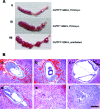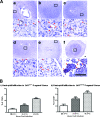Colony-stimulating factor-1-dependent macrophage functions regulate the maternal decidua immune responses against Listeria monocytogenes infections during early gestation in mice
- PMID: 18852237
- PMCID: PMC2612255
- DOI: 10.1128/IAI.01022-08
Colony-stimulating factor-1-dependent macrophage functions regulate the maternal decidua immune responses against Listeria monocytogenes infections during early gestation in mice
Abstract
The association between extreme-prematurity births and intrauterine infection emphasizes the importance of understanding the host immune responses against uterine-invading microbes during early pregnancy to the prevention of preterm births. Listeria monocytogenes, a clinically relevant intracellular bacterium, has a predilection for replication at the maternofetal interface during pregnancy. Here, using mice carrying the recessive null osteopetrotic mutation in the colony-stimulating factor-1 (CSF-1) gene, we show that CSF-1-dependent macrophage functions are required for the maternal decidua immune responses against L. monocytogenes infections during early gestation in mice. In the absence of CSF-1, pregnant mice were more susceptible to uterine infection by L. monocytogenes; their inability to control the expansion of colonized bacteria in the pregnant uterus led to decidual cell death, tissue disintegration, and resorption of the developing embryo. However, CSF-1-deficient mice were able to produce significant levels of both Th1 cytokines and neutrophil chemoattractants and to recruit neutrophils to the decidual tissue in response to Listeria infection. Depletion of macrophages in hormonally induced pseudopregnant mice resulted in higher uterine bacterial levels after L. monocytogenes infection. These data suggest that the anti-Listeria responses in the maternal decidual tissue are dependent on CSF-1-regulated macrophages.
Figures






Similar articles
-
The trophoblast is a component of the innate immune system during pregnancy.Nat Med. 2000 May;6(5):589-93. doi: 10.1038/75074. Nat Med. 2000. PMID: 10802718
-
Limited Colonization Undermined by Inadequate Early Immune Responses Defines the Dynamics of Decidual Listeriosis.Infect Immun. 2017 Jul 19;85(8):e00153-17. doi: 10.1128/IAI.00153-17. Print 2017 Aug. Infect Immun. 2017. PMID: 28507070 Free PMC article.
-
Aberrant macrophage and neutrophil population dynamics and impaired Th1 response to Listeria monocytogenes in colony-stimulating factor 1-deficient mice.Infect Immun. 2001 Mar;69(3):1795-807. doi: 10.1128/IAI.69.3.1795-1807.2001. Infect Immun. 2001. PMID: 11179357 Free PMC article.
-
The role of the activated macrophage in clearing Listeria monocytogenes infection.Front Biosci. 2007 Jan 1;12:2683-92. doi: 10.2741/2364. Front Biosci. 2007. PMID: 17127272 Free PMC article. Review.
-
The cytokine stew and innate resistance to L. monocytogenes.Immunol Rev. 1997 Aug;158:107-14. doi: 10.1111/j.1600-065x.1997.tb00996.x. Immunol Rev. 1997. PMID: 9314078 Review.
Cited by
-
An Update Review on Listeria Infection in Pregnancy.Infect Drug Resist. 2021 May 26;14:1967-1978. doi: 10.2147/IDR.S313675. eCollection 2021. Infect Drug Resist. 2021. PMID: 34079306 Free PMC article. Review.
-
Acute Fetal Demise with First Trimester Maternal Infection Resulting from Listeria monocytogenes in a Nonhuman Primate Model.mBio. 2017 Feb 21;8(1):e01938-16. doi: 10.1128/mBio.01938-16. mBio. 2017. PMID: 28223455 Free PMC article.
-
Methylome of fetal and maternal monocytes and macrophages at the feto-maternal interface.Am J Reprod Immunol. 2012 Jul;68(1):8-27. doi: 10.1111/j.1600-0897.2012.01108.x. Epub 2012 Mar 2. Am J Reprod Immunol. 2012. PMID: 22385097 Free PMC article. Clinical Trial.
-
The class A scavenger receptor, macrophage receptor with collagenous structure, is the major phagocytic receptor for Clostridium sordellii expressed by human decidual macrophages.J Immunol. 2010 Oct 1;185(7):4328-35. doi: 10.4049/jimmunol.1000989. Epub 2010 Sep 1. J Immunol. 2010. PMID: 20810988 Free PMC article.
-
The transcriptional repressor Blimp1/PRDM1 regulates the maternal decidual response in mice.Nat Commun. 2020 Jun 3;11(1):2782. doi: 10.1038/s41467-020-16603-z. Nat Commun. 2020. PMID: 32493987 Free PMC article.
References
-
- Ajuebor, M. N., A. M. Das, L. Virag, R. J. Flower, C. Szabo, and M. Perretti. 1999. Role of resident peritoneal macrophages and mast cells in chemokine production and neutrophil migration in acute inflammation: evidence for an inhibitory loop involving endogenous IL-10. J. Immunol. 1621685-1691. - PubMed
-
- Arceci, R. J., S. Pampfer, and J. W. Pollard. 1992. Role and expression of colony stimulating factor-1 and steel factor receptors and their ligands during pregnancy in the mouse. Reprod. Fertil. Dev. 4619-632.
-
- Austyn, J. M., and S. Gordon. 1981. F4/80, a monoclonal antibody directed specifically against the mouse macrophage. Eur. J. Immunol. 11805-815. - PubMed
-
- Bancroft, G. J., M. J. Bosma, G. C. Bosma, and E. R. Unanue. 1986. Regulation of macrophage Ia expression in mice with severe combined immunodeficiency: induction of Ia expression by a T cell-independent mechanism. J. Immunol. 1374-9. - PubMed
Publication types
MeSH terms
Substances
Grants and funding
LinkOut - more resources
Full Text Sources
Medical
Molecular Biology Databases
Research Materials
Miscellaneous

